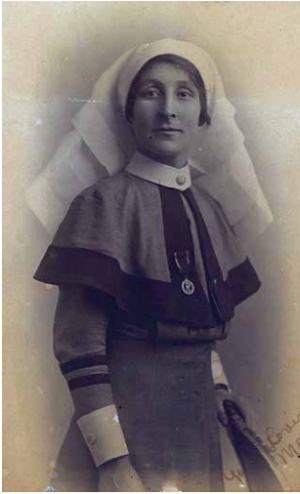Martha Loder: Difference between revisions
No edit summary |
No edit summary |
||
| Line 18: | Line 18: | ||
{{short description|Notable People of Random Island}} | {{short description|Notable People of Random Island}} | ||
{{Person-stub}} | {{Person-stub}} | ||
'''Note: All info summarized from the Newfoundland Historical Society Articles embedded below''' | |||
'''Martha Loder''' is the first Newfoundland woman known to have volunteered as a Nurse during World War One. Loder’s war service overlaps with the initial training of the first 500 of the Newfoundland regiment, and she was in a theatre of war over ten months before the regiment landed in Suvla bay on the night of September 19, 1915. She was demobilized on March 17, 1919.<ref>{{cite book | '''Martha Loder''' is the first Newfoundland woman known to have volunteered as a Nurse during World War One. Loder’s war service overlaps with the initial training of the first 500 of the Newfoundland regiment, and she was in a theatre of war over ten months before the regiment landed in Suvla bay on the night of September 19, 1915. She was demobilized on March 17, 1919.<ref>{{cite book | ||
Revision as of 16:39, 23 September 2021
Martha Isabel Loder | |
|---|---|
 Msrtha Loder | |
| Born | 1884 |
| Died | June 25, 1963 |
| Other names | Mona |
| Occupation | Nurse |
| Known for | First Newfoundland woman known To have volunteered as a nurse during World War One. |
Note: All info summarized from the Newfoundland Historical Society Articles embedded below
Martha Loder is the first Newfoundland woman known to have volunteered as a Nurse during World War One. Loder’s war service overlaps with the initial training of the first 500 of the Newfoundland regiment, and she was in a theatre of war over ten months before the regiment landed in Suvla bay on the night of September 19, 1915. She was demobilized on March 17, 1919.[1]
Early Life
Martha was born in 1884, daughter of John Loder who had moved from Ireland's Eye and was the first settler of Snook's Harbour proper. Her mother, was Jane Tilley Smith, born in Hant's Harbour, but having later settled in Elliott's Cove with her siblings and parents.
She attended the small chapel-schools in Snook's Harbour. Later from about 1906 to 1910 teaching in the Methodist school's in Apsey Brook, Snook's Harbour, and Elliott's Cove, which opened at different times of the year, sharing teachers.
Marha, aka Mona, then moved to study nursing at London Hospital, the largest such school in Great Britain. She graduated from that prestigious school in 1914, and moved to Montreal to do private nursing.
When war was declared, she quickly returned to Great Britain, sailing in October 1914, just days after the first 500 of the Newfoundland Regiment set sail for Devonport.
War Duty
Martha was first assigned to London General Hospital for orientation, from whence she was sent to Boulogne, France. Working in a number of field hospitals and dealing with typhoid, and hospitalization herself due to a vaccine reaction, she became a theatre nurse, working on casualties from some of major war battles, such as the First Battle of Ypres.
Poor conditions, bad sanitization, over work, and lack of sufficient provisions all took their toll, and in December 1915, Loder herself contracted diphtheria. At the time diphtheria had a mortality rate of 15%, and often left its victims with heart and breathing issues, however, Martha was back on duty in five weeks.
On January 18, 1916, Loder was assigned to the 18 General Hospital at Camiers. Its poorly heated tents and wooden barracks would have taxed even the most robust. Camiers received casualties from many regiments. Extreme trauma cases poured in, and because of the contamination, coupled with rats, decomposing animals and humans, all manner of infections set in, exposing medical staff to a high risk.
In mid-June 1917, she was sent to Étaples, a major military base. Étaples’ railways reached both the northern and southern battlefields and it had 16 hospitals. At Étaples, Loder served on the demanding Night Duty shift, mostly at the 24 General Hospital. This was periodically interspersed with short illnesses of her own (gastritis and styes), again requiring hospitalization.
In February 1918, Nurse Loder was transferred to the 11 Stationary Hospital at Rouen, and was promoted to Night Supervisor. Rouen exceeded even Etaples in importance. In addition to its 18 hospitals with a capacity of 20,000 beds, it was a supply and repair base for the British Expeditionary Force with railway yards, a heavy repair workshop for vehicles, petroleum storage tanks, and the 3rd Echelon General Headquarters of the Deputy Adjutant-General.
Loder served in the 11 Stationary Hospital during the period in which it received casualties from the Last German Offensive that began on March 21, 1918
On July 23, 1918, Loder took on her last and most dangerous assignment: the Number 5 Ambulance Train attached to the 6 General Hospital in Rouen. The train would bring her very close to battlefields. This was the culmination of a long-standing wish. In 1915 she expressed frustration that nurses “are not allowed to pick up the wounded [at the front]. I wish we were. I should like it. I hear that no Nursing Sister is allowed within five miles of the firing line.” She ended: “I shall be glad to go nearer if I am wanted.”
She continued to work on the ambulance train till the end of the war.
Later Life
Source Material
All info contained with in this page is a summarization of the wonderful Newfoundland Historical Society article embedded below. <pdf width="800" height="500">File:Aspects.pdf</pdf>
- ↑ Duley, Margot I. NURSE MARTHA ISABEL LODER (1884-1963) AND THE GREAT WAR: From Snook’s Harbour to the Somme (PDF). The Newfoundland Historical Society. p. 1.